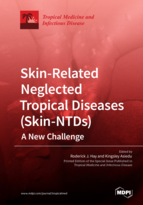Skin-Related Neglected Tropical Diseases (Skin-NTDs)—A New Challenge
A special issue of Tropical Medicine and Infectious Disease (ISSN 2414-6366).
Deadline for manuscript submissions: closed (31 July 2018) | Viewed by 143731
Special Issue Editors
Interests: infections of the skin; tropical dermatology; medical mycology
Special Issues, Collections and Topics in MDPI journals
Special Issue Information
Dear Colleagues,
The skin of the patient is the first and most visible structure of the body that any health care worker encounters in the course of an examination. To the patient and relatives, it is also highly visible and any disease that affects the skin is both noticeable and will have an impact on personal and social wellbeing. It is therefore an important entry point for diagnosis, surveillance, disease mapping and integrated management. Many of the major neglected tropical diseases produce changes in the skin, often the first indicator of illness that patients will notice. Changes to the skin often reinforce the feelings of isolation and stigma experienced by patients with Neglected Tropical Diseases (NTDs), but they also provide opportunities for simplifying diagnosis and developing an integrated and strategic approach to control and care
A key challenge in taking the common feature of skin involvement in NTDs to this higher level is that skin disease in general is very common, particularly in resource-poor settings and seeking solutions to the identification and management of skin NTDs without addressing the commonality of skin disease is not an option.
This Special Issue will explore the range of clinical manifestations and epidemiology of both skin NTDs and common skin disease in endemic regions, the use of common diagnostic and management pathways, the different technologies that play a role in diagnosis and training, and the role of patient and family involvement at the community level, as well as the assessment of the results of different studies or programmes in this field.
Prof. Roderick J. Hay
Dr. Kingsley Asiedu
Guest Editors
Manuscript Submission Information
Manuscripts should be submitted online at www.mdpi.com by registering and logging in to this website. Once you are registered, click here to go to the submission form. Manuscripts can be submitted until the deadline. All submissions that pass pre-check are peer-reviewed. Accepted papers will be published continuously in the journal (as soon as accepted) and will be listed together on the special issue website. Research articles, review articles as well as short communications are invited. For planned papers, a title and short abstract (about 100 words) can be sent to the Editorial Office for announcement on this website.
Submitted manuscripts should not have been published previously, nor be under consideration for publication elsewhere (except conference proceedings papers). All manuscripts are thoroughly refereed through a single-blind peer-review process. A guide for authors and other relevant information for submission of manuscripts is available on the Instructions for Authors page. Tropical Medicine and Infectious Disease is an international peer-reviewed open access monthly journal published by MDPI.
Please visit the Instructions for Authors page before submitting a manuscript. The Article Processing Charge (APC) for publication in this open access journal is 2700 CHF (Swiss Francs). Submitted papers should be well formatted and use good English. Authors may use MDPI's English editing service prior to publication or during author revisions.
Keywords
- Skin disease
- Neglected tropical diseases (NTDs)
- Diagnosis
- Integrated care
- Disease mapping
- Community participation
- Training
- Technology








